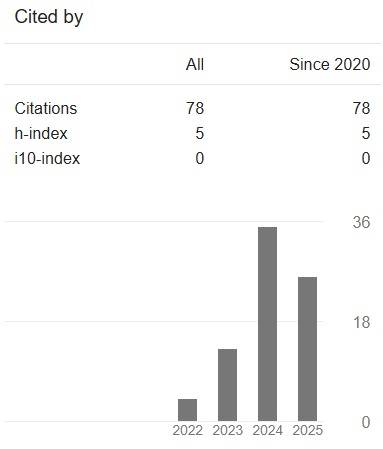Representative Thermal Conductivity of Wickless Heat Pipes in a Thermoelectric Generator Module Design via Computational Numerical Analysis
DOI:
https://doi.org/10.24191/jaeds.v3i1.61Keywords:
thermoelectric generator, heat pipe, waste heat, thermal conductivityAbstract
Thermoelectric generator (TEG) cells are capable of producing electricity from the flow of heat through semiconductor materials via the Seebeck effect. A TEG module (TEM) was developed through the integration of TEG cells, heat pipes, and heat sinks with the function to recover low-temperature waste heat for combined heat and power outputs. The mechanics of heat transport through the components have a distinctive impact on overall performance. Wickless heat pipes were used in the design, and it is difficult to directly evaluate the convection heat transfer coefficient within the heat pipes. Computational numerical analysis usually simplifies the heat pipe by modelling it as a solid copper pipe, where the thermal conductivity of the pipe replaces the actual value of heat transfer coefficient. To determine the representative thermal conductivity of the wickless heat pipe, a computational numerical model of the TEM was developed. Experiment data of the TEM operation, where the cold-side air inlet temperature inlet was at 20.7°C while the hot-side waste heat inlet temperature was at 70.0°C, was used to validate the computational model. The representative thermal conductivity value for the wickless heat pipe was found to be 500 W/m.K, at which the percentage difference for the hot-side and cold-side TEG surface temperatures, and the TEG surface temperature differences were below 5%. The approach has been proven suitable to analyse the representative heat pipe thermal conductivity for simplified thermoelectric generator modules.
Downloads
References
M. Hamid Elsheikh et al., “A review on thermoelectric renewable energy: Principle parameters that affect their performance,” Renew. Sustain. Energy Rev., vol. 30, pp. 337–355, 2014, doi: 10.1016/j.rser.2013.10.027.
B. I. Ismail and W. H. Ahmed, “Thermoelectric power generation using waste-heat energy as an alternative green technology,” Recent Patents Electr. Eng., vol. 2, no. 1, pp. 27–39, 2009, doi: 10.2174/1874476110902010027.
M. F. Remeli, L. Tan, A. Date, B. Singh, and A. Akbarzadeh, “Simultaneous power generation and heat recovery using a heat pipe assisted thermoelectric generator system,” Energy Convers. Manag., vol. 91, pp. 110–119, 2015, doi: 10.1016/j.enconman.2014.12.001.
R. Venkatasubramanian, E. Siivola, T. Colpitts, and B. O’ Quinn, “Thin-film thermoelectric devices with high room-temperature figures of merit,” Mater. Sustain. Energy A Collect. Peer-Reviewed Res. Rev. Artic. from Nat. Publ. Gr., pp. 120–125, 2010, doi: 10.1142/9789814317665_0019.
M. H. Hamdan, N. A. Mat Som, A. Abdul Rashid, and G. J. Jimmy, “Performance analysis on series and parallel circuit configurations of a four-cell thermoelectric generator module design,” J. Appl. Eng. Des. Simul., vol. 1, no. 1, pp. 32–42, 2021, doi: 10.24191/jaeds.v1i1.18.
A. Baroutaji et al., “Advancements and prospects of thermal management and waste heat recovery of PEMFC,” Int. J. Thermofluids, vol. 9, p. 100064, 2021, doi: 10.1016/j.ijft.2021.100064.
S. J. G. Cooper, G. P. Hammond, and J. B. Norman, “Potential for use of heat rejected from industry in district heating networks, Gb perspective,” J. Energy Inst., vol. 89, no. 1, pp. 57–69, 2016, doi: 10.1016/j.joei.2015.01.010.
A. K. Reji, G. Kumaresan, N. Kaushik, V. S. Navin Karthi, and M. K. Naveen, “Thermal analysis of grooved heat pipe with eco-friendly refrigerant for low heat loads in comparison to an ordinary thermosyphon,” Mater. Today Proc., vol. 66, pp. 878–882, 2022, doi: 10.1016/j.matpr.2022.04.512.
M. Mahdi, J. Abdulateef, A. M. Abdulateef, M. Sabah Mahdi, and A. M. Abdulateef, “Thermoelectric Combined Heat and Power Generation System Integrated with Liquid-Fuel Stove Enhancement of Phase Change Materials View project Thermal energy storage View project Thermoelectric Combined Heat and Power Generation System Integrated with Liquid-Fuel Stove,” J. Adv. Res. Fluid Mech. Therm. Sci. J. homepage, vol. 51, pp. 19–30, 2018, [Online]. Available: www.akademiabaru.com/arfmts.html.
Y. Zhang, X. Wang, M. Cleary, L. Schoensee, N. Kempf, and J. Richardson, “High-performance nanostructured thermoelectric generators for micro combined heat and power systems,” Appl. Therm. Eng., vol. 96, pp. 83–87, 2016, doi: 10.1016/j.applthermaleng.2015.11.064.
S. Zarifi and M. Mirhosseini Moghaddam, “Utilizing finned tube economizer for extending the thermal power rate of TEG CHP system,” Energy, vol. 202, Jul. 2020, doi: 10.1016/j.energy.2020.117796.
W. J. Zou, K. Y. Shen, S. Jung, and Y. B. Kim, “Application of thermoelectric devices in performance optimization of a domestic PEMFC-based CHP system,” Energy, vol. 229, Aug. 2021, doi: 10.1016/j.energy.2021.120698.
M. Saufi Sulaiman, B. Singh, and W. A. N. W. Mohamed, “Experimental and theoretical study of thermoelectric generator waste heat recovery model for an ultra-low temperature PEM fuel cell powered vehicle,” Energy, vol. 179, pp. 628–646, 2019, doi: 10.1016/j.energy.2019.05.022.
N. F. Zamri, M. H. Hamdan, S. N. A. Anuar, W. A. N. W. Mohamed, and M. F. Remeli, “Performance of a Plate-Finned Thermoelectric Generator (TEG) Module for Industrial Waste Heat Recovery,” J. Mech. Eng., vol. 19, no. 3, pp. 257–272, 2022, doi: 10.24191/jmeche.v19i3.19817.
Downloads
Published
How to Cite
Issue
Section
License
Copyright (c) 2023 Nur Faranini Zamri, Ahmad Nidhol Rahin, Muhammad Hadrami Hamdan

This work is licensed under a Creative Commons Attribution 4.0 International License.









